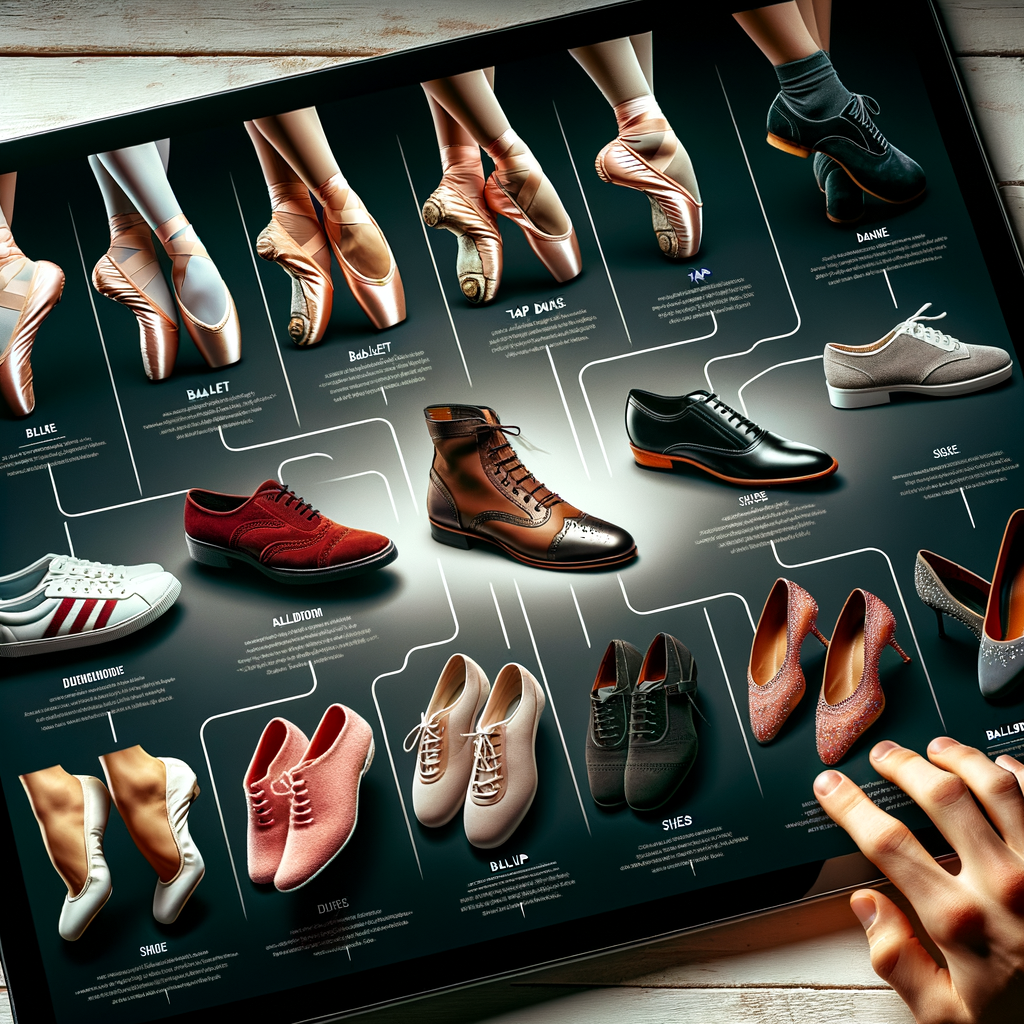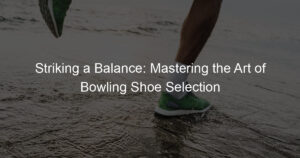
Introduction to Dance Shoe Types
Every dancer knows that the right pair of shoes can make all the difference in their performance. But with so many different types of dance shoes available, how do you know which one is the best for you? In this section, we will delve into the world of dance shoes, helping you understand their importance and how to differentiate between various styles.
-
- Understanding the Importance of the Right Dance Shoes
Choosing the right dance shoes is not just about style, it’s about performance and safety. A well-fitted dance shoe provides the necessary support for your feet, allowing you to move freely and confidently. It can also help prevent injuries. According to a study by the American Academy of Orthopaedic Surgeons, dancers who wear ill-fitting shoes are at a higher risk of foot and ankle injuries. Therefore, investing in the right dance shoes is crucial for every dancer, regardless of their level of expertise.
-
- Differentiating Between Various Dance Shoe Styles
There are several types of dance shoes, each designed for a specific style of dance. Here are a few examples:
| Dance Style | Shoe Type |
|---|---|
| Ballet | Ballet slippers, pointe shoes |
| Tap | Tap shoes with metal plates |
| Jazz | Jazz shoes, dance sneakers |
| Ballroom | Ballroom shoes with suede soles |
| Hip Hop | Dance sneakers, street shoes |
Each of these shoe types has unique features that cater to the specific needs of the dance style. For instance, ballet slippers are lightweight and flexible, allowing dancers to perform intricate footwork. On the other hand, tap shoes have metal plates on the soles to create the characteristic tap sound.
Understanding the different types of dance shoes and their purposes can help you make an informed decision when buying your next pair. Remember, the right shoes can significantly enhance your dance performance and experience.
Essential Dance Footwear for Different Dance Styles
One of the most important aspects of dancing is the footwear. The right pair of shoes can make a significant difference in a dancer’s performance. In this section, we will focus on ballet, one of the most elegant and challenging dance styles.
Ballet
Ballet is a dance style that requires precision, grace, and strength. The shoes worn by ballet dancers are designed to support these requirements. Let’s delve into the characteristics of ballet shoes and some recommended brands.
-
- Characteristics of Ballet Shoes
Ballet shoes, also known as ballet slippers, are designed to be lightweight and flexible. They are typically made from soft leather, canvas, or satin. The soles are thin and flexible to allow dancers to flex and point their feet easily. The shoes are secured with elastic bands across the arch and around the ankle. Here are some key characteristics:
| Characteristic | Description |
|---|---|
| Material | Soft leather, canvas, or satin |
| Sole | Thin and flexible |
| Fit | Snug, but not too tight |
-
- Recommended Brands for Ballet Shoes
There are many brands that offer high-quality ballet shoes. Here are a few that are highly recommended by professional ballet dancers:
-
- Bloch: Known for their comfort and durability, Bloch ballet shoes are a popular choice among dancers.
- Capezio: Capezio is another well-respected brand in the dance world. Their ballet shoes are praised for their fit and flexibility.
- Grishko: Grishko ballet shoes are loved for their craftsmanship and the support they provide.
Remember, the best ballet shoe is the one that fits well and feels comfortable. It’s always a good idea to try on several pairs and brands to find the perfect fit for your feet.
Tap Dance
Tap dance is a unique style that combines rhythm, precision, and a whole lot of fun. The shoes you wear for tap dancing play a critical role in your performance. Let’s explore the features of tap dance shoes and some of the top brands you can consider.
- Features of Tap Dance Shoes
Tap dance shoes are quite distinctive. They are designed to create a specific sound when the dancer’s foot strikes the floor. Here are some key features:
- Tap Plates: These are metal plates attached to the heel and toe of the shoe. They produce the characteristic tap sound.
- Material: Tap shoes are typically made of leather or synthetic materials. Leather shoes offer better flexibility and durability.
- Fit: A good tap shoe fits snugly without pinching or discomfort. It should provide ample support to the foot.
- Heel: Tap shoes come with various heel heights. Beginners usually start with flat or low-heeled shoes for better stability.
- Top Tap Dance Shoe Brands
When it comes to tap dance shoes, some brands stand out for their quality, comfort, and sound. Here are a few top picks:
| Brand | Notable Features |
|---|---|
| Bloch | Known for their superior sound quality and comfortable fit. |
| Capezio | Offers a wide range of styles for beginners and professionals alike. |
| So Danca | Renowned for their durability and stylish designs. |
Remember, the best tap shoe is the one that fits well, sounds great, and makes you feel confident on the dance floor. Happy tapping!
Hip Hop
When it comes to the energetic and dynamic world of hip hop dance, the right footwear can make a significant difference. Let’s explore the essential features of hip hop dance shoes and some of the best brands in the market.
- Essential features of hip hop dance shoes
Hip hop dance shoes are unique in their design and functionality. Here are some of the essential features to look for:
- Comfort: Hip hop involves a lot of movement and footwork. Therefore, the shoes should be comfortable to wear for long periods.
- Durability: Given the intensity of hip hop dance, the shoes need to be durable to withstand the rigorous routines.
- Support: Good hip hop dance shoes should provide excellent ankle and arch support to prevent injuries.
- Flexibility: The shoes should be flexible enough to allow for a wide range of movements.
- Grip: A good grip is essential to prevent slipping during dance routines.
- Best hip hop dance shoe brands
Here are some of the top brands known for their high-quality hip hop dance shoes:
| Brand | Key Features |
|---|---|
| Nike | Known for their comfort, durability, and stylish designs. |
| Adidas | Offers excellent support and flexibility for hip hop dancers. |
| Puma | Renowned for their grip and flexibility, making them ideal for hip hop dance. |
| Reebok | Provides a perfect balance of comfort, support, and style. |
Choosing the right hip hop dance shoes can significantly enhance your performance and reduce the risk of injuries. Remember, the best shoe for you is the one that fits well, supports your foot, and matches your style of dance.
Dance Shoe Buying Guide
Whether you’re a beginner or a seasoned dancer, choosing the right dance shoes can make a significant difference in your performance and comfort. This guide will help you understand the key factors to consider when buying dance shoes and where to find quality ones.
Factors to Consider When Buying Dance Shoes
When buying dance shoes, it’s important to consider several factors to ensure you get the right pair for your needs. Here are some key points to keep in mind:
- Fit: Your dance shoes should fit snugly, but not too tight. They should provide enough room for your toes to move, but not so much that your foot slides around.
- Material: Dance shoes are typically made from leather or synthetic materials. Leather shoes tend to be more durable and breathable, but they can also be more expensive. Synthetic shoes are usually cheaper and easier to clean.
- Sole: The sole of the shoe is also important. Some dance styles require a certain type of sole. For example, ballet shoes have a soft, flexible sole, while tap shoes have a hard, sturdy sole.
- Style: The style of the shoe can also affect your performance. For instance, high heels are commonly used in Latin dance, while flat shoes are more suitable for ballet and contemporary dance.
Where to Buy Quality Dance Shoes
Once you know what to look for in a dance shoe, the next step is to find a reliable place to buy them. Here are a few options:
- Dance Stores: Physical dance stores are a great place to start. They usually have knowledgeable staff who can help you find the right shoe for your dance style and foot shape.
- Online Retailers: There are many online retailers that specialize in dance shoes. They often have a wider selection than physical stores, and you can read reviews from other customers to help make your decision.
- Dance Schools: Some dance schools also sell dance shoes. This can be a convenient option if you’re already taking classes there.
Remember, the most important thing is to choose a pair of dance shoes that feel comfortable and enhance your performance. Happy dancing!
Best Shoes for Dancing: Top Recommendations
When it comes to dancing, the right shoe can make all the difference. The best dance shoes not only provide comfort but also enhance your performance. Here are our top recommendations for both men and women.
-
Top Rated Dance Shoes for Men
Men’s dance shoes need to offer stability, flexibility, and comfort. Here are a few top-rated options:
- Capezio Men’s SD103 Social Dance Shoe: Known for its comfort and durability, this shoe is a favorite among many male dancers. It features a suede sole that allows for easy turns and slides.
- Very Fine Men’s Salsa Ballroom Tango Latin Dance Shoes: These shoes come with a cushioned insole for shock absorption and comfort. The suede sole provides excellent flexibility for any dance style.
- Adidas Men’s Dance Sneakers: Perfect for hip-hop or street dance, these sneakers offer excellent support and are very comfortable for long dance sessions.
-
Top Rated Dance Shoes for Women
Women’s dance shoes should provide support, flexibility, and a snug fit. Here are some top-rated choices:
- Bloch Women’s Boost Dance Sneaker: This shoe is perfect for jazz or hip-hop styles. It features a built-in arch support and a spin spot for easy turns.
- Capezio Women’s EJ2 E-Series Jazz Slip-On: A popular choice for many dancers, this shoe offers a flexible, barefoot feel. It also has a low profile for a sleek look.
- Very Fine Women’s Ballroom Dance Shoes: These shoes are ideal for Latin, salsa, or any type of ballroom dancing. They come with a suede sole for easy gliding and a cushioned insole for comfort.
Remember, the best shoe for you depends on your specific needs and dance style. Always try on several options and choose the one that feels the most comfortable and supportive.
Dance Styles and Shoe Requirements
Every dance style has its unique shoe requirements. The right pair of shoes can make a significant difference in a dancer’s performance, comfort, and safety. Let’s explore the different dance styles and their respective shoe requirements.
- Matching dance styles with the right shoes
Just like a football player needs the right cleats, a dancer needs the right shoes. Ballet dancers, for example, wear pointe shoes to allow them to dance on the tips of their toes. Tap dancers wear shoes with metal taps on the soles to create their distinctive sound. Ballroom dancers need shoes with suede soles for the right amount of slide on the dance floor.
For hip-hop dancers, sneakers with good support and flexibility are essential. Meanwhile, contemporary dancers often prefer to dance barefoot or in soft dance shoes to feel the floor better. The list goes on, but the key is to match the dance style with the appropriate shoes.
- Understanding shoe requirements for different dance styles
Understanding the shoe requirements for different dance styles is crucial. Here are some examples:
| Dance Style | Shoe Requirement |
|---|---|
| Ballet | Pointe shoes or ballet slippers |
| Tap | Shoes with metal taps |
| Ballroom | Shoes with suede soles |
| Hip-Hop | Sneakers with good support and flexibility |
| Contemporary | Barefoot or soft dance shoes |
Remember, the right dance shoes not only enhance your performance but also protect you from injuries. So, always choose your dance shoes wisely.
Choosing Dance Shoes: Practical Tips
Choosing the right dance shoes can make a big difference in your performance. Here are some practical tips to help you make the best choice.
-
How to Choose the Right Size
Choosing the right size is crucial when buying dance shoes. Shoes that are too big or too small can cause discomfort and even injury. Here’s how to get the right size:
- Measure your foot: Use a ruler or tape measure to measure the length of your foot from heel to toe.
- Try on shoes: Always try on shoes before buying. They should fit snugly but not too tight. Your toes should not be squished, and there should be no excessive pressure on any part of your foot.
- Walk around: Walk around in the shoes to make sure they feel comfortable. If they hurt or feel uncomfortable, they’re probably not the right size.
-
Choosing Between Different Materials
Dance shoes are made from various materials, each with its own pros and cons. Here’s a quick guide:
Material Pros Cons Leather Durable, molds to your foot, provides good support Can be expensive, requires regular maintenance Satin Lightweight, flexible, good for ballroom dancing Not as durable as leather, can stain easily Canvas Lightweight, breathable, good for ballet and jazz Not as supportive as leather, can wear out quickly When choosing a material, consider the type of dance you’ll be doing, your comfort, and your budget.
Dance Shoe Recommendations for Beginners
As a beginner, finding the right dance shoes can be a daunting task. There are numerous brands and styles to choose from, and it’s crucial to find a pair that not only fits well but also complements your dance style. Let’s explore some of the best dance shoes for beginners and tips for buying your first dance shoes.
-
- Best Dance Shoes for Beginners
When starting your dance journey, comfort should be your top priority. Here are a few recommendations:
-
-
- Bloch Dance Women’s Boost DRT Suede and Mesh Split Sole: These shoes are perfect for beginners due to their lightweight design and split sole, which offers flexibility and support.
- Capezio Men’s SD103 Social Dance Shoe: This shoe offers a comfortable fit and a sleek design, making it ideal for beginners.
- STELLE Girls Canvas Ballet Slipper: These slippers are comfortable, durable, and affordable, making them a great choice for young beginners.
- Tips for Beginners Buying Their First Dance Shoes
-
Here are some tips to help you make an informed decision when buying your first pair of dance shoes:
-
- Comfort is Key: Your dance shoes should be comfortable. They should fit well and not cause any discomfort or pain.
- Choose the Right Size: Dance shoes should fit snugly, but not too tight. It’s often recommended to go a half size down from your regular shoe size for a proper fit.
- Consider the Dance Style: Different dance styles require different types of shoes. For example, ballet requires ballet slippers, while tap dance requires tap shoes.
- Quality Over Price: While it might be tempting to go for the cheapest option, it’s important to invest in quality shoes that will last and provide the necessary support.
Dance Footwear Essentials: Maintenance and Care
Just like a car needs regular servicing, your dance shoes also require proper maintenance and care. This not only extends their lifespan but also ensures they remain comfortable and supportive during your dance routines. Let’s explore how to maintain and care for your dance shoes and address common problems you may encounter.
-
How to Maintain and Care for Your Dance Shoes
Proper maintenance of your dance shoes begins with regular cleaning. Use a soft cloth to wipe off any dirt or sweat after each use. For leather shoes, consider using a leather conditioner to keep them supple and shiny.
Always store your dance shoes in a cool, dry place away from direct sunlight. This helps to prevent the material from cracking or fading. Additionally, use shoe trees or crumpled newspaper to help maintain the shape of your shoes when not in use.
Remember, dance shoes are designed for the dance floor. Wearing them outside can damage the soles and reduce their lifespan. Always carry them in a shoe bag and put them on only when you reach the dance studio.
-
Common Dance Shoe Problems and Solutions
Despite your best efforts, you may still encounter some common problems with your dance shoes. Here are a few and how to address them:
Problem Solution Worn out soles Consider resoling your shoes at a professional cobbler. This is often cheaper than buying a new pair. Loose straps Straps can be tightened or replaced by a cobbler. Alternatively, you can learn to do it yourself with some basic sewing skills. Uncomfortable fit Shoes that don’t fit well can cause discomfort and even injuries. Always ensure your shoes are the right size. If they’re too tight, a cobbler can help stretch them for a better fit.
In conclusion, taking care of your dance shoes is an essential part of your dance journey. With proper maintenance and care, your shoes will serve you well, providing comfort and support as you express yourself on the dance floor.
Conclusion: Elevating Your Performance with the Right Dance Shoe Styles
As we wrap up this comprehensive guide on dance shoes, it’s essential to revisit the critical points we’ve discussed. The right pair of dance shoes can significantly impact your performance, comfort, and overall dance experience.
-
- Recap of the importance of choosing the right dance shoes
Choosing the right dance shoes is not just about style; it’s about enhancing your performance and protecting your feet from injury. Different dance styles require specific types of shoes, and understanding these requirements is crucial. For example, ballet dancers need pointe shoes for their intricate footwork, while tap dancers require shoes with metal taps for their rhythmic patterns. The right shoes can provide the necessary support, flexibility, and grip, enabling you to perform your best.
-
- Final thoughts on dance shoe selection
In conclusion, the process of selecting dance shoes should be approached with careful consideration. Remember, the best dance shoe is one that fits well, matches your dance style, and meets your comfort needs. It’s always worth investing in quality dance shoes, as they can significantly improve your performance and reduce the risk of injury. Keep in mind the practical tips and recommendations we’ve discussed in this guide as you embark on your dance shoe selection journey.
Ultimately, the right dance shoes can elevate your performance, making every move more precise, every step more comfortable, and every dance more enjoyable. So, take your time, do your research, and choose wisely. Your feet—and your dance—will thank you!









